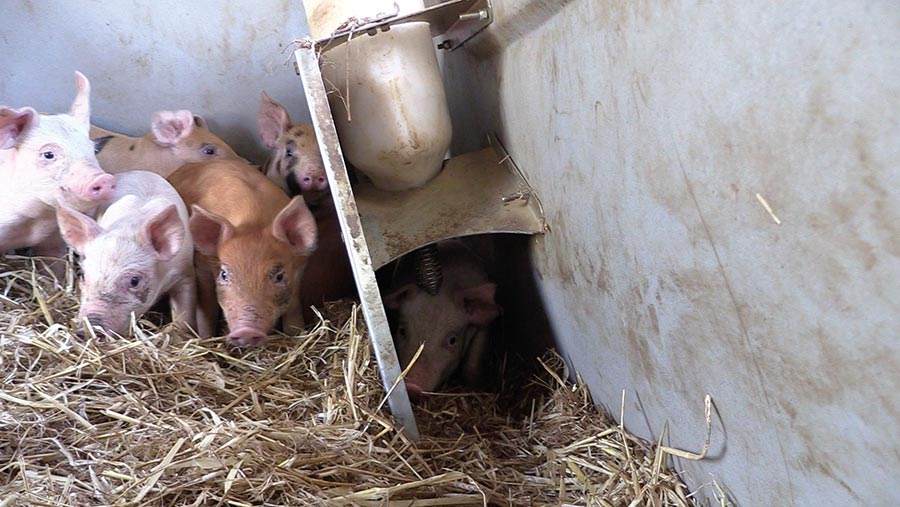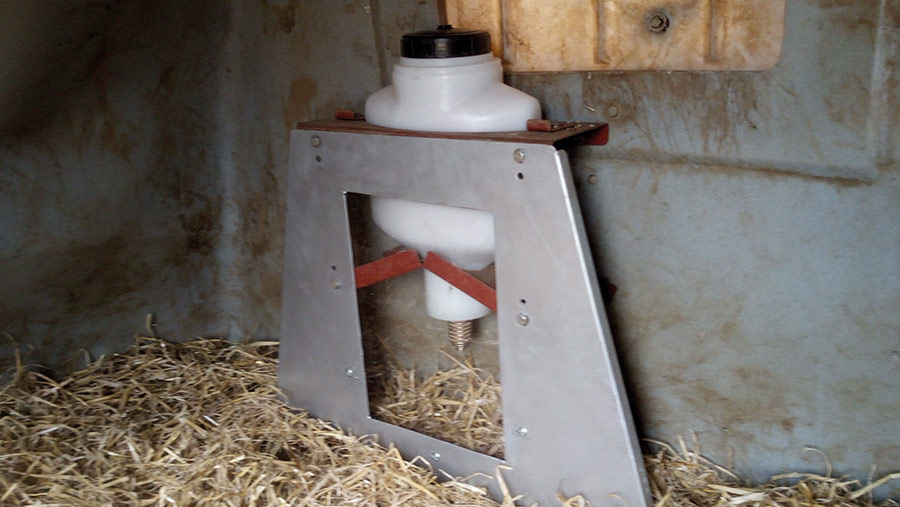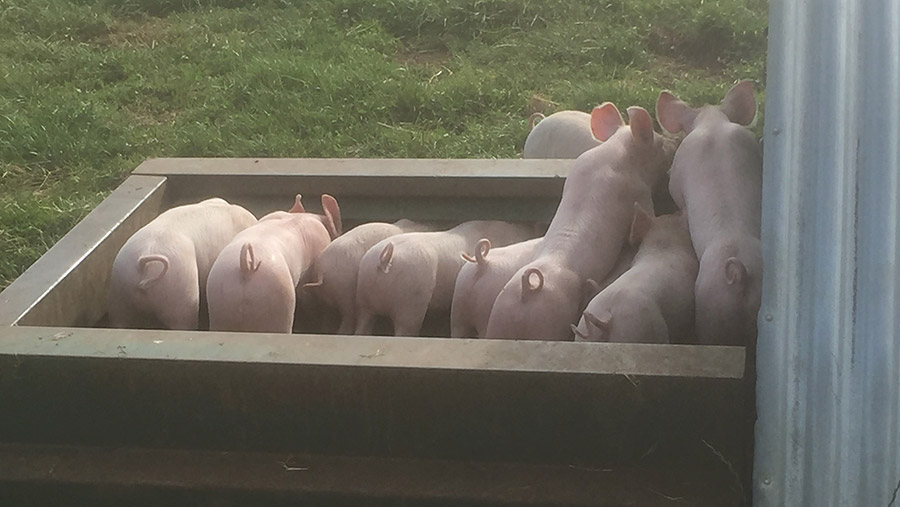Video: Norfolk pig farmers showcase creep-feeder inventions
 © Michael Priestley
© Michael Priestley The days of sows pilfering expensive creep feed are over on two outdoor pig units in Norfolk, which have each designed a feeder to prepare piglets for life after weaning.
Both sow-proof creep feeders allow the farms to reap the widely known benefits of creep feeding while avoiding the major headaches of feed being wasted in bedding or soil.
In doing so, the contraptions enable the two farms to rise to the challenge of lowering antibiotics and zinc oxide use by weaning older, stronger piglets.
Many in the industry believe the trend of weaning piglets later – some at five weeks – makes creep feeding essential due to their size and energy requirement.
See also: 5 ways to reduce stress when weaning pigs
Gut conditioning
Vet John Hayden of Integra Vet Services, a branch of the Garth Pig Practice, stresses that a creep-feeding system should provide dry feed in addition to sow’s milk – it should not replace milk and risk sows being dried off and coming on heat early.
He says a little creep feed develops the production of the digestive enzymes amylase and protease, which help the weaned pig transition to grower rations.
If pigs aren’t introduced to creep before weaning, there is a greater chance of hard feed passing undigested into the hindgut, where it can accumulate and become a breeding ground for bacteria such as E coli and other pathogens. This can lead to scours and post-weaning diarrhoea.
Mr Hayden also recommends discussing lysine levels and lower-protein diets with nutritionists, and focusing on optimal – rather than maximum – protein levels as a way of controlling scours without zinc oxide.
Two designs
A spring-release hopper on the back of the farrowing ark is the invention of LSB Pigs, and the Allen family have devised a front fender feeder system in a system similar to other moulded fender feeder options available.
The full effects of these systems are still being researched, but anecdotal reports indicate that conditioning the gut to dry feed is helping pigs grow faster and reducing days to slaughter.
Creep feeder station, LSB Pigs, East Rudham
Design
A zinc-plated, trapezium-shaped steel barrier prevents sow access and cradles a translucent, polyethylene, 4.5kg-capacity feed hopper with a waterproof screw lid. A high-tensile, spring-release system dispenses feed like a game or poultry hopper.
The creep feeder station (CFS) is attached with bolts or antiluce fasteners to the rear of the farrowing ark. Hoppers are easily removed from the cradle via the back window, and feed levels can be checked and refilled.
Farm facts
- 1,500-sow outdoor unit, producing weaned pigs for BQP
- RSPCA- and Red Tractor-assured system
- Using Landrace cross Duroc genetics
- Three-week batch farrowing
- Creep feeding from 21 days and weaning at 28 days
- Pigs fit into barley and sugar beet rotation
- Rearing 26 pigs a sow a year at 11.8 pigs a litter
How the farm uses it
- Creep feeders are filled up with creep when piglets are 21 days old, and they are weaned at 28 days. A week on feed manages the risk of sows drying off too early
- Piglets smell the sweet-smelling creep feed and usually start eating it within two or three days of it being introduced
- The hopper contents have been weighed and checked, revealing that the piglets start eating 15-20g a head a day and consume a total of 350g a week
- Staff use a funnel to fill the hopper through the rear door of the farrowing ark quickly and with minimal waste
- At a cost of about £600/t for high-quality piglet creep, the total for 4.5kg of creep over the week for 12-14 piglets is about £2.70, or 19-22.5p a piglet
Design benefits
- Provides a reliable ad-lib supply of feed for seven days from one fill, keeping it fresh, dry and out of reach of birds and sows
- Sows still have ample space to lie down to farrow and suckle pigs, and piglets have room to play and rest
- Spring-release system drops most feed on the floor, promoting natural ground-foraging behaviour
- Several days of feed can be safely stored, minimising time spent feeding piglets

© LSB Pigs
Future
-
Independent trial work is comparing weaning weights across different creep-fed systems
-
ForFarmers and BQP will compare animals given no creep at all with floor-fed, trough-fed and the CFS-fed piglets, and track growth and performance through to finished weight
Cost
Expected to retail at £70-£80 (plus VATt), depending on volume bought
Allen family’s front fender feeder, Morleys Farm, South Creake

© Morleys Farm
Design
The feeder is a trough system that runs the full length of the fender to allow the whole litter to access creep feed.
It is made of a single piece of 2mm metal sheet that is attached to the fender by antiluce bolts.
A wider overhang is angled above the feed space and serves three purposes:
- Prevents the sow from accessing feed
- Keeps weather out and minimises interest from birds
- Prevents the feeder being pulled off the fender when the sow climbs over to forage, as her feet slip off the overhang.
Farm facts
- 340 JSR T9 sows put to Hampshires
- Weans at five weeks old every fortnight
- Achieves 12.69 pigs weaned a litter and 2.21 litters a sow a year
- Sells into local butchers, farm shops and Blakes of Norwich
- Everything reared and finished outdoors in weaner kennels and then tents, mainly to 82-85kg carcasses
- Holkham Estate tenancy (fourth generation)
- 222ha (550 acres) including sugar beet, oilseed rape, winter wheat and spring and winter barley
- 02-0.4mg/kg antibiotics used in 2020
How the farm uses it
- Piglets are introduced to creep at seven to 10 days old, and take from one day to a week to get going. Piglets are weaned at 35 days
- The amount of feed typically hits a maximum level of 375-400g a litter a day. The rule is: if it’s gone the following morning, increase the amount slightly, and if there is some left, decrease the amount
- Sows are fed first and then piglets are topped up with creep and straw, if needed. Once mum has finished breakfast she lies down and feeds the piglets as normal
- Piglets still eat 6kg of creep, but a sizeable proportion of this is now eaten earlier, meaning piglets move onto their 8kg allocation of second-stage creep sooner
Design benefits
- Proved to be hard-wearing, with no breakages in more than three years
- Pigs are allowed to eat together at close to suckling height
- Fender feeding means the sow and piglets are enticed out of the ark, allowing for it to be checked for slow or dead pigs and bedding-up to take place
- Stronger piglets do well with or without creep, but creep helps the smaller animals by balancing out the milk they don’t get because of bullying
- The farm has found a transition gut helps entry to grower accommodation, higher weaning weights and lower mortality
Future
- BQP has trials on the go, with 20 troughs looking at different creep-fed and non-creep-fed piglets
- Another 20 troughs are being trialled on a farm in Suffolk, and a Lincolnshire unit has bought some to try out, with positive early results
Cost
£45 (plus VAT)

